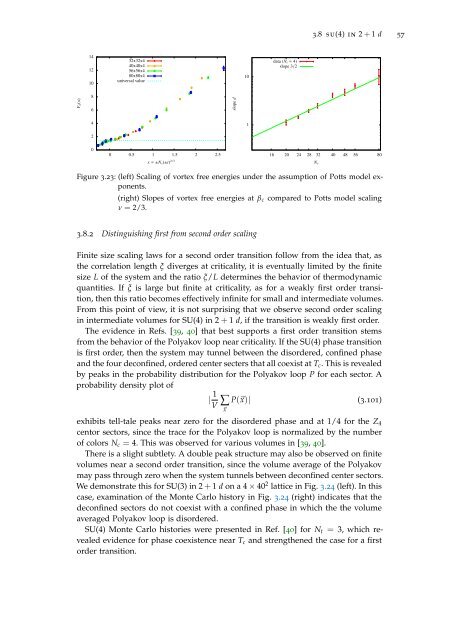Topology, symmetry, and phase transitions in lattice gauge ... - tuprints
Topology, symmetry, and phase transitions in lattice gauge ... - tuprints
Topology, symmetry, and phase transitions in lattice gauge ... - tuprints
Create successful ePaper yourself
Turn your PDF publications into a flip-book with our unique Google optimized e-Paper software.
3.8 su(4) <strong>in</strong> 2 + 1 d 57<br />
14<br />
12<br />
10<br />
32x32x4<br />
40x40x4<br />
56x56x4<br />
80x80x4<br />
universal value<br />
10<br />
data (N t = 4)<br />
slope 3/2<br />
Fk(x)<br />
8<br />
6<br />
slope d<br />
4<br />
1<br />
2<br />
0<br />
0 0.5 1 1.5 2 2.5<br />
x = ±N s(±t) 2/3<br />
16 20 24 28 32 40 48 56 80<br />
N s<br />
Figure 3.23: (left) Scal<strong>in</strong>g of vortex free energies under the assumption of Potts model exponents.<br />
(right) Slopes of vortex free energies at β c compared to Potts model scal<strong>in</strong>g<br />
ν = 2/3.<br />
3.8.2 Dist<strong>in</strong>guish<strong>in</strong>g first from second order scal<strong>in</strong>g<br />
F<strong>in</strong>ite size scal<strong>in</strong>g laws for a second order transition follow from the idea that, as<br />
the correlation length ξ diverges at criticality, it is eventually limited by the f<strong>in</strong>ite<br />
size L of the system <strong>and</strong> the ratio ξ/L determ<strong>in</strong>es the behavior of thermodynamic<br />
quantities. If ξ is large but f<strong>in</strong>ite at criticality, as for a weakly first order transition,<br />
then this ratio becomes effectively <strong>in</strong>f<strong>in</strong>ite for small <strong>and</strong> <strong>in</strong>termediate volumes.<br />
From this po<strong>in</strong>t of view, it is not surpris<strong>in</strong>g that we observe second order scal<strong>in</strong>g<br />
<strong>in</strong> <strong>in</strong>termediate volumes for SU(4) <strong>in</strong> 2 + 1 d, if the transition is weakly first order.<br />
The evidence <strong>in</strong> Refs. [39, 40] that best supports a first order transition stems<br />
from the behavior of the Polyakov loop near criticality. If the SU(4) <strong>phase</strong> transition<br />
is first order, then the system may tunnel between the disordered, conf<strong>in</strong>ed <strong>phase</strong><br />
<strong>and</strong> the four deconf<strong>in</strong>ed, ordered center secters that all coexist at T c . This is revealed<br />
by peaks <strong>in</strong> the probability distribution for the Polyakov loop P for each sector. A<br />
probability density plot of<br />
| 1 V ∑ ⃗x<br />
P(⃗x)| (3.101)<br />
exhibits tell-tale peaks near zero for the disordered <strong>phase</strong> <strong>and</strong> at 1/4 for the Z 4<br />
centor sectors, s<strong>in</strong>ce the trace for the Polyakov loop is normalized by the number<br />
of colors N c = 4. This was observed for various volumes <strong>in</strong> [39, 40].<br />
There is a slight subtlety. A double peak structure may also be observed on f<strong>in</strong>ite<br />
volumes near a second order transition, s<strong>in</strong>ce the volume average of the Polyakov<br />
may pass through zero when the system tunnels between deconf<strong>in</strong>ed center sectors.<br />
We demonstrate this for SU(3) <strong>in</strong> 2 + 1 d on a 4 × 40 2 <strong>lattice</strong> <strong>in</strong> Fig. 3.24 (left). In this<br />
case, exam<strong>in</strong>ation of the Monte Carlo history <strong>in</strong> Fig. 3.24 (right) <strong>in</strong>dicates that the<br />
deconf<strong>in</strong>ed sectors do not coexist with a conf<strong>in</strong>ed <strong>phase</strong> <strong>in</strong> which the the volume<br />
averaged Polyakov loop is disordered.<br />
SU(4) Monte Carlo histories were presented <strong>in</strong> Ref. [40] for N t = 3, which revealed<br />
evidence for <strong>phase</strong> coexistence near T c <strong>and</strong> strengthened the case for a first<br />
order transition.
















